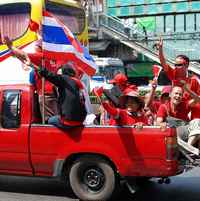The tragedy in Bangkok on Saturday, April 10, marked what is for now the low point of the ongoing political crisis that has plagued Thailand since mid-2005. The deadliest political violence the country has seen in almost 20 years claimed a total of 24 lives, including 18 protesters, 5 soldiers and a Japanese news cameraman, and injured more than 800 people. On the surface, the incident appeared to be a clash between the soldiers and the so-called "Red Shirt" protesters. In reality, however, Thailand's political struggle is much more complex and involves multiple players, each with their own specific, and often conflicting, agendas. It would be a mistake to take anything at face value, or to treat any of the stakeholders as monolithic.
Western media is fond of describing the current Thai conflict as a confrontation between the urban, rich "Yellow Shirts," backed by the military and the royalists, and the rural, poor "Red Shirts," financed by former Prime Minister Thaksin Shinawatra and his allies. While this is partly correct, it fails to address the fact that both sides are highly fragmented. These internal divisions are in fact the decisive factor that turned a relatively peaceful standoff between the military and the Red Shirts into a bloodbath.
It is important to highlight some of these fragmentations. Not all of the Red Shirts currently demonstrating are supporters of Thaksin. A significant portion of them are Bangkok residents who share the grievances of the Reds and truly believe that the voices of the rural poor need to be heard by the ruling elites. Although they see the movement as a convenient way to show their solidarity with the less fortunate Thais, they are not blind to Thaksin's corruption and oppose his attempt to manufacture a political comeback. On the other hand, there are also some among the Red Shirts who are paid to protest and are clearly being co-opted by Thaksin's camp as political tools. Further division within the Red camp exists among those who prefer hard-line measures and those who favor a peaceful movement.

